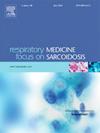茚达特罗与噻托溴铵对生物质暴露所致慢性阻塞性肺病患者改善生活质量和减轻症状的疗效对比。
IF 3.5
3区 医学
Q2 CARDIAC & CARDIOVASCULAR SYSTEMS
引用次数: 0
摘要
背景:很少有治疗COPD患者与生物质烟雾暴露(COPD- b)相关的试验。COPD-B患者在吸入长效β受体激动剂(LABA)和长效毒瘤碱拮抗剂(LAMA)后24小时可改善恶性通货膨胀,并在治疗6个月后改善症状、生活质量和恶化。然而,在COPD-B表型中,LAMA或LABA在延长时间内改善生活质量和症状的有效性尚未得到证实。该试验的主要目的是比较噻托溴胺(TIO)与吲哚卡特罗(IND)在改善COPD-B患者治疗6个月后圣乔治呼吸问卷(SGRQ)测量的生活质量(QOL)方面的差异。方法:一项随机、开放标签、平行组临床试验设计在墨西哥城的三级卫生机构。73名患有慢性阻塞性肺病的妇女被随机分配到150微克的因达特罗或18微克的噻托溴铵,每天一次,持续24周。结果:197例患者接受了筛查访视,其中73例随机抽取。两个治疗组在这三个领域和SGRQ总分上均无显著变化。对于次要结果,TIO组在治疗6个月后IC显著变化为160 mL (p=0.016)。两个治疗组的BDI/TDI评分均显著降低3分(p结论:TIO和IND均未改善生活质量,也未改善mMRC量表评估的呼吸困难,但TIO确实改善了吸气量,TIO和IND改善了BDI/TDI评估的呼吸困难。临床试验注册:NCT05506865。本文章由计算机程序翻译,如有差异,请以英文原文为准。
Efficacy of Indacaterol vs Tiotropium in COPD patients due to biomass exposure in improving quality of life and reducing symptoms
Background
Few treatment trials have been tested on COPD patients associated with biomass smoke exposure (COPD-B). Patients with COPD-B improve hyperinflation 24 hours after inhaling long-acting beta-agonist (LABA) and long-acting muscarinic antagonist (LAMA), and after six months of treatment, improve symptoms, quality of life, and exacerbations. However, the usefulness of LAMA or LABA for an extended period for improving quality of life and symptoms has not yet been demonstrated in the COPD-B phenotype. The primary aim of this trial was to compare tiotropium (TIO) with indacaterol (IND) in improving the quality of life (QOL) measured by the Saint George's Respiratory Questionnaire (SGRQ) in COPD-B after six months of treatment.
Methods
A randomized, open-label, parallel-group clinical trial designed at a third-level health institute in Mexico City. Seventy-three COPD-B women were randomly assigned to either 150 mcg of indacaterol or 18 mcg of tiotropium once daily for 24 weeks.
Results
197 patients underwent the screening visit, of which 73 were randomized. There was no significant change in the three domains nor the total score of the SGRQ in either treatment group. For secondary outcomes, the TIO group showed a substantial change in the IC of 160 mL (p=0.016) after six month-treatment. For both treatment groups, a significant reduction in BDI/TDI score of 3 points was shown (p<0.001).
Conclusions
Neither TIO nor IND improved quality of life, nor dyspnea evaluated by the mMRC scale, but TIO did improve inspiratory capacity, and TIO and IND improved dyspnea evaluated by BDI/TDI.
Clinical Trial Registration
NCT05506865
求助全文
通过发布文献求助,成功后即可免费获取论文全文。
去求助
来源期刊

Respiratory medicine
医学-呼吸系统
CiteScore
7.50
自引率
0.00%
发文量
199
审稿时长
38 days
期刊介绍:
Respiratory Medicine is an internationally-renowned journal devoted to the rapid publication of clinically-relevant respiratory medicine research. It combines cutting-edge original research with state-of-the-art reviews dealing with all aspects of respiratory diseases and therapeutic interventions. Topics include adult and paediatric medicine, epidemiology, immunology and cell biology, physiology, occupational disorders, and the role of allergens and pollutants.
Respiratory Medicine is increasingly the journal of choice for publication of phased trial work, commenting on effectiveness, dosage and methods of action.
 求助内容:
求助内容: 应助结果提醒方式:
应助结果提醒方式:


